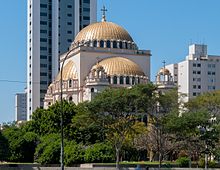You can help expand this article with text translated from the corresponding article in Portuguese. (February 2021) Click [show] for important translation instructions.
|
| Catedral Metropolitana Ortodoxa | |
|---|---|
| Orthodox Metropolitan Cathedral of São Paulo | |
Catedral Metropolitana Ortodoxa de São Paulo | |
 | |
 | |
| 23°34′32″S 46°38′25″W / 23.57564°S 46.64017°W | |
| Location |
|
| Country | Brazil |
| Denomination | Greek Orthodox Church of Antioch |
| Website | www |
| History | |
| Consecrated | 1978 |
| Architecture | |
| Style | Neo-Byzantine |
| Groundbreaking | 1942 |
| Completed | January 1954 |
| Clergy | |
| Archbishop | The Most Rev. Metr. Damaskinos (Mansour) |
The Orthodox Metropolitan Cathedral of São Paulo (Portuguese: Catedral Metropolitana Ortodoxa de São Paulo), also known as the Orthodox Cathedral of São Paulo, is a cathedral of the Greek Orthodox Church of Antioch, located at 1515 Vergueiro in Paraíso, Vila Mariana, São Paulo, Brazil. Dedicated to Paul the Apostle, it is home to the Antiochian Orthodox Archdiocese of São Paulo and All Brazil. It was constructed to serve the many Lebanese Brazilians of the Orthodox Christian faith who had been immigrating to Brazil since the late 19th century. It is one of the largest Eastern Orthodox cathedrals in the world,[1] and a fine example of Byzantine Revival architecture.[2]
History
[edit]Construction of the cathedral began in 1942, inspired by the Hagia Sophia,[1] and built under the supervision of Paul Taufick Camasmie with the architects Francisca Galvão Bueno and Igor Sresnewsky.[3] Joseph Trabulsi was personally selected by King Farouk of Egypt to participate in its decoration. Wladimir Krivoutz worked on the cathedral's marble iconostasis.
The cathedral was inaugurated in January 1954, along with the celebrations of the quatercentenary of the city of São Paulo,[4] and consecrated by Patriarch Elias IV and Metropolitan Ignátios Ferzli in 1978.
See also
[edit]References
[edit]- ^ a b Robinson, Alex; Robinson, Gardênia (2011-05-17). Brazil Handbook (7 ed.). Footprint Books. p. 198. ISBN 978-1-907263-26-2. OCLC 884358349. OL 26046029M. Retrieved 2012-08-30.
- ^ Akmir, Abdeluahed, ed. (2009). Los árabes en América Latina: Historia de una emigración [The Arabs in Latin America: Story of an Emigration]. Biblioteca de Casa Árabe (in Spanish). Madrid: Casa Árabe e Instituto Internacional de Estudios Árabes y del Mundo Musulmán. p. 249. ISBN 978-84-323-1419-3. LCCN 2013408284. OCLC 750893353. OL 24112875M. Retrieved 2012-08-30.
- ^ Ficher, Sylvia (2017-06-12) [1989]. "O Curso de Arquitetura da Escola de Engenharia Mackenzie, 1917–1947" [The Architecture Course at the Mackenzie School of Engineering] (PDF). Mackenzie Presbyterian University (in Portuguese). Archived (PDF) from the original on 2019-09-19. Retrieved 2018-11-29.
- ^ Rahme, Claudinha (2013-04-20). "Catedral Metropolitana Ortodoxa de São Paulo" [Orthodox Metropolitan Cathedral of São Paolo]. Gazeta de Beirute (in Portuguese). Archived from the original on 2019-08-24. Retrieved 2016-08-03.
External links
[edit]